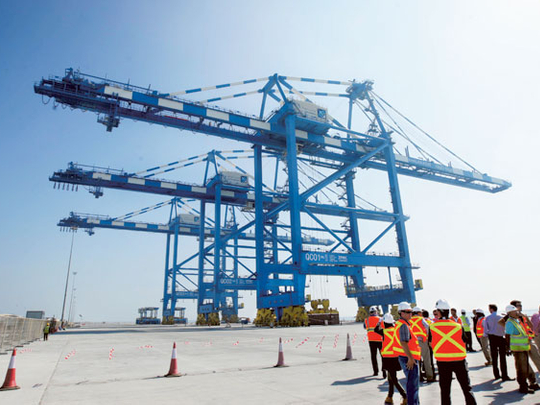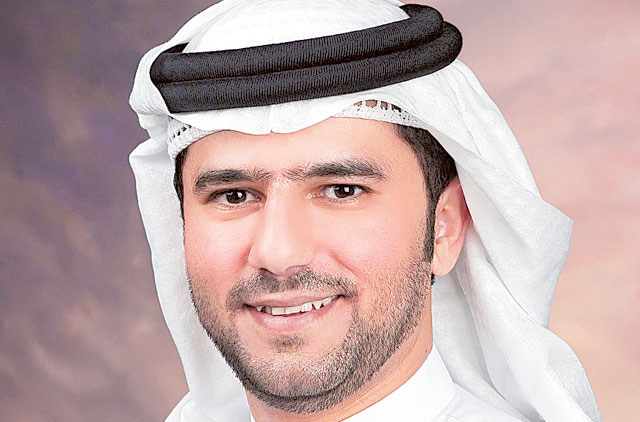
Abu Dhabi: Abu Dhabi Ports Company (ADPC), master developer and regulator of ports and industrial zones in Abu Dhabi, expects that more direct destinations will be added to ADPC’s businesses throughout this year, particularly Americas, Captain Mohammad Al Shamisi, (ADPC)’s acting CEO told Gulf News.
Al Shamisi added that the more direct destinations the lower the shipping costs and easy access for investors and merchants to these markets, pointing out that the UAE is amongst the top 20 exporters of liner goods by value, as well as in imports of containerized cargo.
“We are a focal point for regional trade. We have invested heavily in new infrastructure and the latest technologies. As a result we have been able to develop our position as a logistics platform for a much wider region,” said Al Shamisi.
Q. What is the number of cargoes handled? Are there new shipping lines?
A. April 2013 has witnessed a healthy trend with the number of handled cargoes increasing by 20 per cent compared to the same period of 2012. We are on the right track. April 2013 witnessed marine activities in all Abu Dhabi ports. April 2013, the number of containers handled amounted to 64,040 containers compared to 53,323 containers for the same period of 2012.
The general and bulk cargos, represented by Emal, Bourouge and Emirates Steel, also increased. In April 2013, we handled 1,172,156 metric tonnes, a 55.7 per cent increase compared to the same period of 2012. This growth is due to the kick off of Emirates Steel Phase II, and Emal’s Phase II which is expected to be completed by end of 2013. The fourth agreement was with Al Dahra Agriculture to establish an agri-business distribution hub at Khalifa Port. General bulk and cargo, for all ports operated by ADPC, saw a throughput of 9.4 million tonnes in 2012, an increase of 8.7 per cent on that handled in 2011 . We are working on all fronts. In line with 2030, our sustained capabilities within industry, we managed to diversify our resources. Ships in the past used to come to our ports loaded and return empty and now they come loaded and leave loaded too with UAE products from Emal, Emirates Steel and Borouge as well as others to the world.
Q. We have heard that there is a surprise that will be announced soon, can you give us some details?
A. One of our clients will be transporting via sea from the northern emirates 2-4 million tonnes of rocks and stones to his factory in Mussaffah at ICAD and this will be the kick off of transporting heavy building raw materials via the sea to save our infrastructure which has been affected badly because of heavy loads. In addition, sea transportation will help decrease the costs of shipping and the prices in general.
Q. How many direct destinations does (ADPC) have so far?
A. Actually we have more than 64 four direct destinations. Game is still on, we need to open new direct destinations to be added to the 64+ direct destinations to include Americas and we are looking forward to doing this as this will decrease costs for our clients and will help them direct access to other markets. We cover most parts of Asia, Europe, GCC, Africa and Middle East and North Africa (Mena) region. The more direct destination the more we serve merchants and investors to help them have access to the desired ports. During Q1 we have signed different agreements with maritime companies.
Q. What is the status of Mina Zayed now?
A. We expect a big jump this year for tourism in Abu Dhabi. We are very busy in terms of business at Mina Zayed. Mina Zayed will continue with commercial cargo, and concentrate on developing the growing cruise liner business at the port. It is ideally situated in the heart of the city centre. The degree of planning around the development of these business assets has been impressive and underlines Abu Dhabi’s rigorous approach of only constructing port capacity or developing existing ports, when the market for it already exists. We are refocusing on Mina Zayed to become a cruise hub or businesses. We will have the permanent location for the cruise business from next season. The cruise ships will be in the permanent location. We are master planning the cruise terminal to develop a permanent cruise terminal to the permanent location. End of April 2013 we received 10,422 cruise tourists compared to 6,629 for the same period last year, a 58 per cent increase. Last season which started from October to April/May 2012, about 156,000 passengers were going through Mina Zayed. This season of 2013 it is expected that the number will rise to 165,000 passengers because Mina Zayed will grow. One of the shipping lines, namely MSC, will use Mina Zayed as a hub.
Q. How about RORO (roll-on/roll-off) businesses at Mina Zayed?
A. This is an exciting business. If you look outside you will notice that there are many vehicles coming on deck to Abu Dhabi. In April 2013, RORO saw an increase by 20 per cent to 7792 vehicles handled compared to 6500 for the same period last year. The number of vehicles handled since January until end of April 2013 increased by 29.3 per cent to reach 32,727 compared to 25,270 for the same period last year. Roro witnessed the highest increase in growth with movements up significantly at 41.4 per cent, from 56,510 units to 79,906 units; marine activity saw a 13.8 per cent increase, up from 26,899 to 30,618 vessel calls, over the previous year.
Q. What is the status of Khalifa Port since its launch in December 2012?
A. Khalifa Port, which has the 2.5 m TEU (initial) capacity, deep-water port, went operational from September 1, 2012, now handles all container shipments into and out of Abu Dhabi. We passed the transition period which is the most critical period for us. We managed it successfully. Now our main focus is to open a direct destination from and to Khalifa Port. We signed with Messina Line few days ago as they will take Khalifa Port as their home port. We started connections with Africa, Asia, Europe and in the coming weeks we will be announcing new destinations and shipping lines that will serve Abu Dhabi directly. This is the big shift. Now Khalifa Port has started to transform quickly into being a hub port. Khalifa Port is a huge investment by Abu Dhabi, offering customers from the region and other parts of the world a one-stop shop for container business, providing bespoke solutions that meet and exceed their expectations. We look forward to building to full capacity over several phases in the future,
It is expected that the number of containers to be handled by Khalifa Port to surpass the significant milestone figure of one million TEUs (standard twenty-foot equivalent container unit) per annum, later this year.
Q. Will you reduce your prices?
A. Our prices for this year were fixed as last year. We have no idea about next year. However, the UAE is currently handling more than 65 per cent of the GCC sea cargoes.
Q. How do you view the market?
A. I was in a meeting with other GCC officials in this regard and I asked to join our efforts in order to reduce the cost by reaching certain destinations as all of us ship to same destinations. Therefore, I asked them to use Khalifah Port as this will help them reach their direct destinations at lower costs and to consolidate cargoes. We have witnessed a shift of trade from the north to the south, with expectations that trade with Europe to increase more than with Asia in terms of Polymers and petrochemicals as the European demand would increase by 5 per cent and the GCC demand on these product would increase by 7 per cent. This is not the case with Asia, mainly China, as it is building its own factories and plants for this purpose.
Ports and shipping are perhaps the world’s first truly global industry, connecting countries, businesses and people, ports have played a key role in driving international trade. Over the years, the growth of the UAE as a global trading destination also owes to its investments in expanding the port infrastructure.













